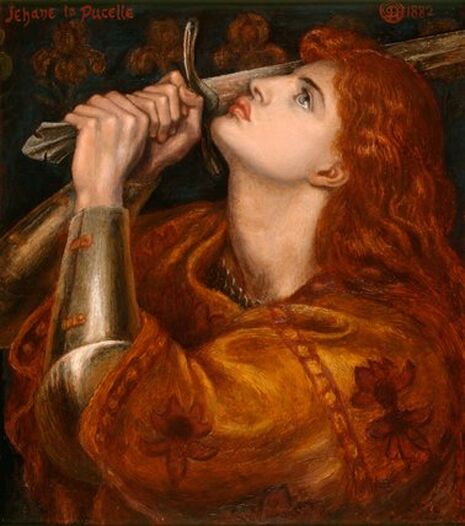A closer look: Joan of Arc
Thea Hawlin takes a closer look at what’s on display in the Fitzwilliam

As we enter exam term, one could do worse than take inspiration from Joan of Arc. She’s one of history’s bravest heroes. Emerging from poverty and obscurity in war-torn France at 17, Jeanne d’Arc managed to rally a demoralised army and change the course of history; exams don’t look so bad now do they?
In spite of the evident significance of who it depicts, this painting by Rossetti is also a work unto itself, a thing of beauty. Rossetti manages to capture something other than a physical beauty, he captures spirit. Yes his Joan is beautiful, more akin to Waterhouse’s Lady of Shallot than a French peasant, but through this beauty Rossetti depicts a strength and determination.
Jeanne created a new role for herself, although she was born a peasant she immortalised herself in history as a woman of courage and conviction. She donned men’s clothing and proved that women were equal to men both on the battle field and off it. More than that, she proved a peasant could fight just as nobly as a member of the nobility. She took the constraints of gender and class and fought against them.
In the words of the immortal Kate Bush: “Joanni, Joanni wears a golden cross/And she looks so beautiful in her armour/Joanni, Joanni blows a kiss to God/And she never wears a ring on her finger”. In simple terms Joan of Arc doesn’t need ‘a man to complete her’, all she needs is herself. Holding her weapon of choice (finalists substitute the blade for a pen here) she looks upwards and onwards, begging for it all to be over and yet continuing on the strife despite it all (again, finalists take note).
This was one of the last paintings Rossetti would complete in his lifetime, yet it is one of his most hopeful. Joan’s eyes are locked on what is to come. She has faith, not merely in the divine presence, but in her own abilities. Her hands are clasped in prayer but also in knowing determination.
You may not be going to a literal battle this term, but Joan may still serve as an inspiration.
 Interviews / ‘People just walk away’: the sense of exclusion felt by foundation year students19 April 2024
Interviews / ‘People just walk away’: the sense of exclusion felt by foundation year students19 April 2024 News / Controversy on the Cam: John’s spend almost 90 times more on rowing than other colleges19 April 2024
News / Controversy on the Cam: John’s spend almost 90 times more on rowing than other colleges19 April 2024 Theatre / The closest Cambridge comes to a Drama degree 19 April 2024
Theatre / The closest Cambridge comes to a Drama degree 19 April 2024 News / Corpus student left with dirty water for over six months21 April 2024
News / Corpus student left with dirty water for over six months21 April 2024 News / Emmanuel College cuts ties with ‘race-realist’ fellow19 April 2024
News / Emmanuel College cuts ties with ‘race-realist’ fellow19 April 2024





